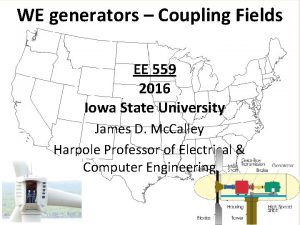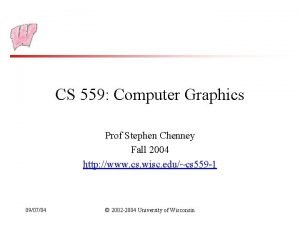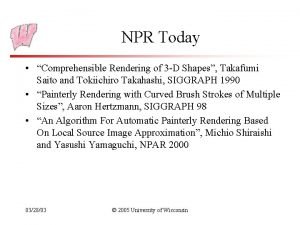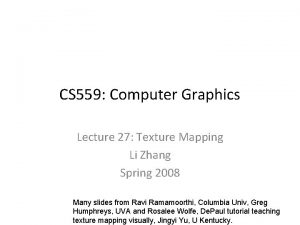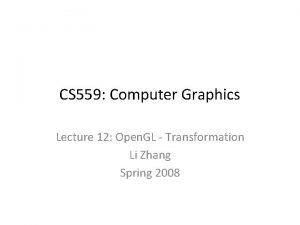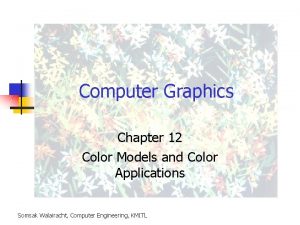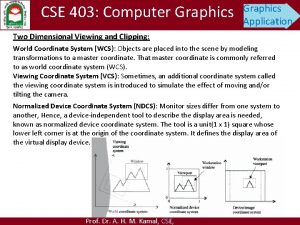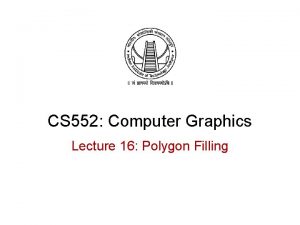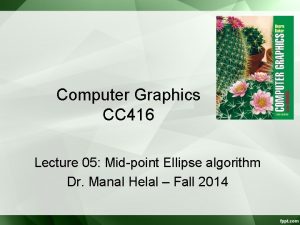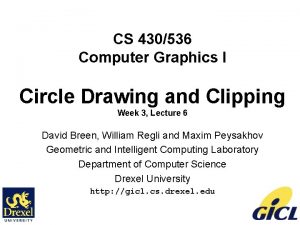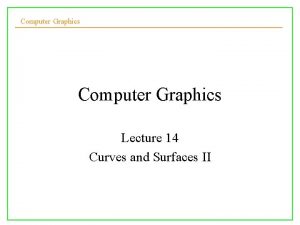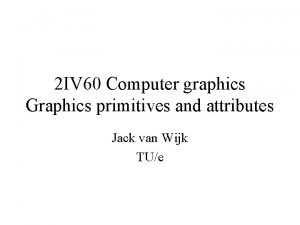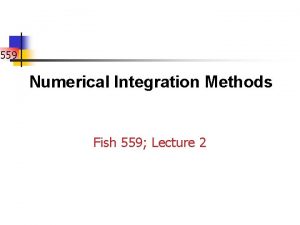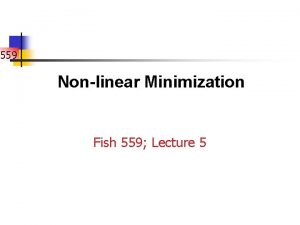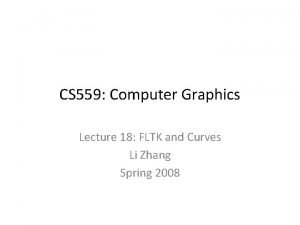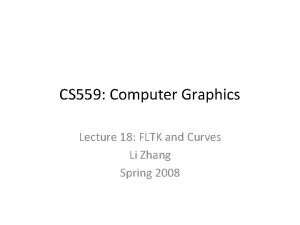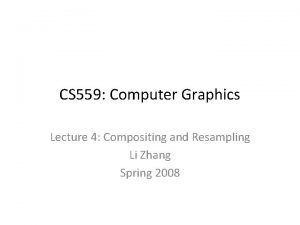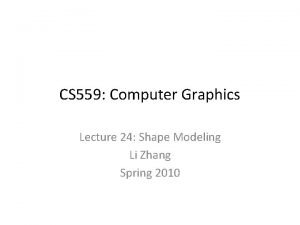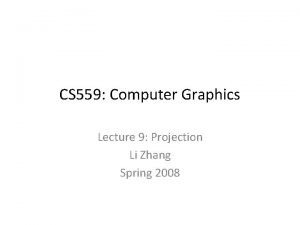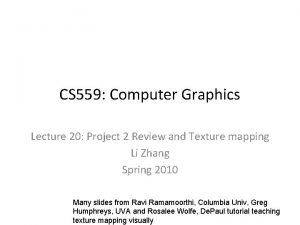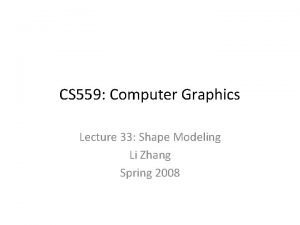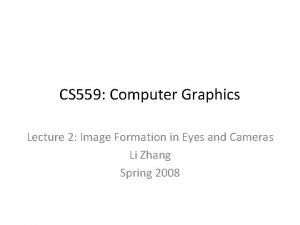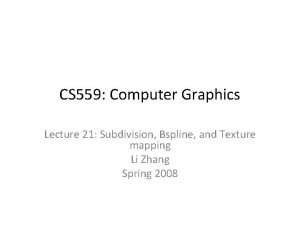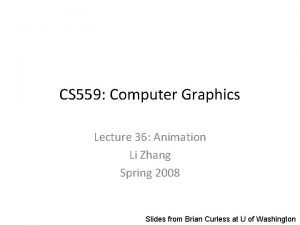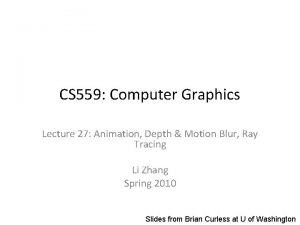CS 559 Computer Graphics Lecture 5 Color and





![Trichromacy For almost any given E_target(λ), we can solve for [r, g, b] so Trichromacy For almost any given E_target(λ), we can solve for [r, g, b] so](https://slidetodoc.com/presentation_image_h2/9d2aad71ad0fd6d088d807cc5edb3acb/image-6.jpg)

![Other Color Space • Hue-Saturation-Value (HSV) [Alvy Smith, 1978] – Hue: dominant color component Other Color Space • Hue-Saturation-Value (HSV) [Alvy Smith, 1978] – Hue: dominant color component](https://slidetodoc.com/presentation_image_h2/9d2aad71ad0fd6d088d807cc5edb3acb/image-8.jpg)

























- Slides: 33

CS 559: Computer Graphics Lecture 5: Color and Edge Li Zhang Spring 2008

Today • Eyes • Cameras

Image as a discreet function Represented by a matrix

Color Vision Three kinds of cones:

Trichromacy • Experiment: – Show a target color spectrum beside a user controlled color – User has knobs that adjust primary sources to set their color • Primary sources are just lights with a fixed spectrum and variable intensity – Ask the user to match the colors – make their light look the same as the target • Experiments show that it is possible to match almost all colors using only three primary sources - the principle of trichromacy • Sometimes, have to add light to the target • In practical terms, this means that if you show someone the right amount of each primary, they will perceive the right color • This was how experimentalists knew there were 3 types of cones 9/14/04 © University of Wisconsin, CS 559 Spring 2004
![Trichromacy For almost any given Etargetλ we can solve for r g b so Trichromacy For almost any given E_target(λ), we can solve for [r, g, b] so](https://slidetodoc.com/presentation_image_h2/9d2aad71ad0fd6d088d807cc5edb3acb/image-6.jpg)
Trichromacy For almost any given E_target(λ), we can solve for [r, g, b] so that the displayed color looks indistinguishable from the target color to our eyes.

RGB Cube Cyan (0, 1, 1) White(1, 1, 1) Green(0, 1, 0) Yellow (1, 1, 0) Blue (0, 0, 1) Black (0, 0, 0) Magenta (0, 1, 1) Red (1, 0, 0) Demo
![Other Color Space HueSaturationValue HSV Alvy Smith 1978 Hue dominant color component Other Color Space • Hue-Saturation-Value (HSV) [Alvy Smith, 1978] – Hue: dominant color component](https://slidetodoc.com/presentation_image_h2/9d2aad71ad0fd6d088d807cc5edb3acb/image-8.jpg)
Other Color Space • Hue-Saturation-Value (HSV) [Alvy Smith, 1978] – Hue: dominant color component – Saturation: color purity – Value: lightness or brightness • HSV-RGB transformation http: //alvyray. com/Papers/hsv 2 rgb. htm http: //www. mandelbrot-dazibao. com/HSV. htm

Other Color Space • L-A-B – L: luminance – A: position between magenta and green (negative values indicate green while positive values indicate magenta) – B: position between yellow and blue (negative values indicate blue and positive values indicate yellow) http: //en. wikipedia. org/wiki/Lab_color_space http: //en. wikipedia. org/wiki/CIE_1931_color_space

Spatial resolution and color R G B original

Blurring the G component R G B original processed

Blurring the R component R G B original processed

Blurring the B component R G B original processed

Lab Color Component L a b A rotation of the color coordinates into directions that are more perceptually meaningful: L: luminance, a: magenta-green, b: blue-yellow

Bluring L L a b original processed

Bluring a L a b original processed

Bluring b L a b original processed

Application to image compression • (compression is about hiding differences from the true image where you can’t see them).

Edge Detection • Convert a 2 D image into a set of curves – Extracts salient features of the scene – More compact than pixels

How can you tell that a pixel is on an edge?

Edge detection • One of the most important uses of image processing is edge detection: – Really easy for humans – Really difficult for computers – Fundamental in computer vision – Important in many graphics applications

What is an edge? • Q: How might you detect an edge in 1 D?

Gradients • The gradient is the 2 D equivalent of the derivative: • Properties of the gradient – It’s a vector – Points in the direction of maximum increase of f – Magnitude is rate of increase • How can we approximate the gradient in a discrete image?

Less than ideal edges

Steps in edge detection • Edge detection algorithms typically proceed in three or four steps: – Filtering: cut down on noise – Enhancement: amplify the difference between edges and non-edges – Detection: use a threshold operation – Localization (optional): estimate geometry of edges, which generally pass between pixels

Edge enhancement • A popular gradient magnitude computation is the Sobel operator: • We can then compute the magnitude of the vector (sx, sy).

Results of Sobel edge detection

Canny Edge Detector • Smooth image I with 2 D Gaussian: • Find local edge normal directions for each pixel • Along this direction, compute image gradient • Locate edges by finding max gradient magnitude (Non-maximum suppression)

Non-maximum Suppression • Check if pixel is local maximum along gradient direction – requires checking interpolated pixels p and r

The Canny Edge Detector original image (Lena)

The Canny Edge Detector magnitude of the gradient

The Canny Edge Detector After non-maximum suppression

Canny Edge Detector original • The choice of – large – small Canny with depends on desired behavior detects large scale edges detects fine features Canny with
 Hand held computer
Hand held computer Dot matrix display ppt
Dot matrix display ppt Ee 559
Ee 559 Cs 559
Cs 559 Cs 559 uw madison
Cs 559 uw madison Redbook 559
Redbook 559 Cs 559
Cs 559 Intuitive color concepts in computer graphics
Intuitive color concepts in computer graphics 01:640:244 lecture notes - lecture 15: plat, idah, farad
01:640:244 lecture notes - lecture 15: plat, idah, farad In two dimensional viewing we have?
In two dimensional viewing we have? Drawing algorithms
Drawing algorithms Computer graphics ppt
Computer graphics ppt What is window and viewport in computer graphics
What is window and viewport in computer graphics Shear transformation in computer graphics
Shear transformation in computer graphics Mathematical foundations of computer graphics and vision
Mathematical foundations of computer graphics and vision Ppt
Ppt 8 connected boundary fill algorithm
8 connected boundary fill algorithm Hardware and software of computer graphics
Hardware and software of computer graphics Mid point ellipse drawing algorithm
Mid point ellipse drawing algorithm Scan conversion algorithm for line circle and ellipse
Scan conversion algorithm for line circle and ellipse What is pixmap in computer graphics
What is pixmap in computer graphics Difference between horizontal retrace and vertical retrace
Difference between horizontal retrace and vertical retrace Circle and ellipse drawing algorithm in computer graphics
Circle and ellipse drawing algorithm in computer graphics Curves and surfaces for computer graphics
Curves and surfaces for computer graphics Aliasing and antialiasing in computer graphics
Aliasing and antialiasing in computer graphics Convex and concave polygon in computer graphics
Convex and concave polygon in computer graphics Computer security 161 cryptocurrency lecture
Computer security 161 cryptocurrency lecture Computer-aided drug design lecture notes
Computer-aided drug design lecture notes Computer architecture lecture notes
Computer architecture lecture notes Computer architecture lecture
Computer architecture lecture Java gui
Java gui Crt in computer graphics
Crt in computer graphics Projection in computer graphics
Projection in computer graphics Display devices in computer
Display devices in computer


